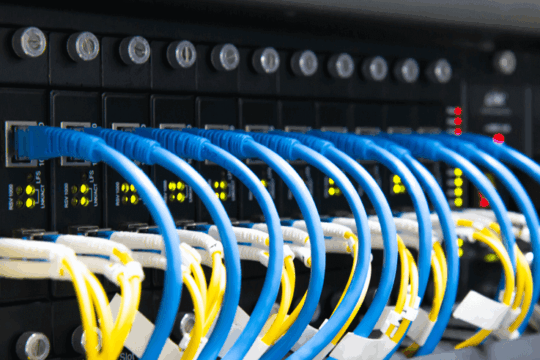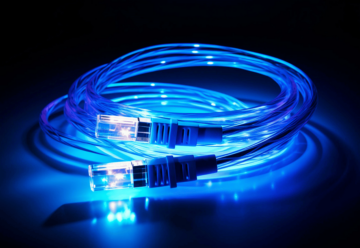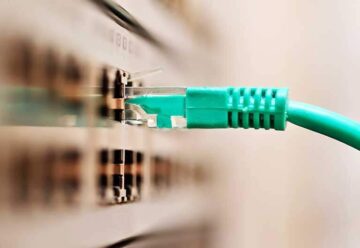Business Ethernet
Resilient, high-bandwidth connectivity for your business
What is Ethernet resilience?
Ethernet resilience is the ability of your Ethernet network to maintain or quickly recover service when faults, failures or cyberattacks occur.
You can achieve resilience by design. That means building in diversity, redundancy and failover:
- Diversity (separation): two or more independent paths, such as fibre routes entering your building through different ducts.
- Redundancy: spare capacity or duplicate components that take over if one fails, for example, dual routers or twin power supplies.
- Failover: the mechanism that switches traffic from a failed component or route to the backup.
Failover plays a vital role. Without it, diverse paths or spare capacity won’t protect your business when the primary service fails.
Why does Ethernet resilience matter for your business?
Ethernet resilience is vital because network outages can cost you dearly. In 2024, 72% of senior IT decision makers said that resilience problems led to disruption or downtime. And over 50% of businesses admitted suffering substantial financial losses after a major resilience disruption.
Strong resilience minimises downtime and disruption. By keeping your network running, it ensures business continuity when disaster strikes. But it’s not just about money.
It protects your reputation. Customers expect you to be available, and repeated outages can quickly erode trust.
It also underpins disaster recovery and data protection. In 2024, 43% of UK businesses reported experiencing a cybersecurity breach or attack. With a resilient network design, you can restore services quickly and reduce the risk of data loss.
And it supports growth. A resilient network keeps your team connected and productive, giving your business the stability it needs to thrive.
To build resilience, you first need to understand the threats your Ethernet network faces.
What are the main threats to Ethernet connectivity?
Cyberattacks overtook hardware failures as the leading cause of IT outages in UK businesses in 2024, accounting for 24% of incidents, up from just 10% in 2018. However, physical risks, such as fibre duct damage from roadworks, deliberate cable cuts, or infrastructure faults, remain common threats to Ethernet connectivity.
Here’s a summary of the main threats:
| Threat | Impact on your Ethernet network |
| Cyberattacks | From ransomware to phishing, malicious actors can cause downtime, data loss and reputational harm. |
| DDoS attacks | Attackers can overwhelm your network with traffic, disrupting service availability unless defences are in place. |
| Outdated systems or devices | Legacy equipment with old firmware or insecure protocols creates vulnerabilities and instability. |
| Physical disruption / WAN link failures | Fibre cuts, duct damage, or exchange faults can take you offline instantly. |
| Insufficient bandwidth | Congested links slow performance and risk outages during peaks or heavy workloads. |
| Equipment misconfiguration | Human error in setup or maintenance remains a significant cause of downtime. |
That's why you need resilience designed into your Ethernet network.
Resilience options for your business Ethernet
Resilience depends on removing single points of failure. That means building in diversity, redundancy and failover across every layer of your Ethernet service.
Resilience Option 2 (RO2)
Resilience Option 2 (RO2) provides true route diversity in the last-mile/access network connecting your business to your provider’s infrastructure. RO2 provides two circuits with separate physical routes into your local site, for example, different ducts, cabling or entry points. This protects against physical damage, like fibre cuts and roadworks, one of the most common causes of downtime.
Without RO2, even if you order two circuits from Openreach or through different providers, Openreach will install via the shortest available path. So the two circuits will often share the same local routing.
RO2 provides local route diversity at the Physical Layer (Layer 1 of the OSI model). Paired with the right routing or redundancy protocols, it enables seamless failover: if one circuit goes down, the other seamlessly takes over.
Dual-homing
Dual-homing means connecting to two points of presence (PoPs) or network-to-network interfaces (NNIs). Even if you’ve bought RO2, both circuits may still terminate at the same provider PoP or NNI. That means a single point of failure.
Two separate hand-off points remove that risk: if one PoP fails, your traffic routes via the other.
Router redundancy
A third resilience option is redundant routing at the customer edge – where your premises connects to the access network. Even with RO2 and dual-homing, your customer premises equipment (CPE) or router can be a single point of failure. If your router or default gateway fails, it can cut off your whole site.
Using a virtual default gateway protocol like VRRP, a backup router automatically takes over if your primary router fails.
Shadow VLANs
A fourth option is shadow VLANs, which provide resilience at the Data Link Layer (Layer 2). A VLAN (virtual local area network) lets providers run independent, isolated connections over shared infrastructure, keeping your traffic safe and separate.
With shadow VLANs, a backup VLAN runs alongside your primary one. If the main data link fails, traffic can be redirected to the secondary data link using the shadow VLAN. That protects against faults or misconfigurations inside the provider’s Ethernet platform, adding a second, independent logical path through the provider’s core.
DDoS resilience
The physical and logical diversity options above strengthen your Ethernet connectivity, but they won’t protect your internet access if your connection is overwhelmed by malicious traffic. That’s where DDoS resilience comes in.
With Dedicated Internet Access (DIA), leading providers offer DDoS protection that filters or “scrubs” attacks before they reach your network. This helps ensure you stay online even under DDoS attack, protecting your business from one of the most common causes of downtime.
Core network resilience
The resilience of your Ethernet connection is only as strong as your provider’s core network. Leading carriers invest in high capacity, low latency backbones engineered for resilience.
For example, Neos Networks’ UK-wide core network uses a resilient mesh topology with diverse fibre routes. MPLS and IP fast reroute keep traffic moving seamlessly if a path goes down. Meanwhile, our Network Operations Centre (NOC) monitors the network 24/7, detecting and resolving faults before they affect your service.
All the above options can add resilience to your Ethernet network. The challenge is choosing the right mix for your business. That’s where Neos Networks can help.
Ethernet resilience and diversity solutions
At Neos Networks, our Business Ethernet services are built on our high capacity, UK-wide core network designed for Critical National Infrastructure. Scalable up to 100Gbps, they come with a full range of resilience options, from RO2 to shadow VLANs and more.
Business Ethernet
Resilient, high-bandwidth connectivity for your business
If you’re looking for Dedicated Internet Access (DIA), we provide services up to 10Gbps with resilience options including RO2, dual-homing and DDoS protection – all delivered using Ethernet as an underlay across our nationwide core network.
Not sure what connectivity is right for your mission-critical network? Get in touch. We’ll help you choose the resilient connectivity your business needs.





